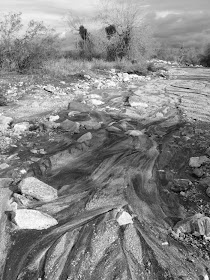 |
| A Sonoran Desert ephemeral drainage the morning after a flash flood. |
Flash Flood
A few lucky times a year, storms bringing an inch or more of rain move across the landscape. Storms like these, depending on how hard and fast the rain comes, will quickly saturate soil surfaces. In these cases, instead of absorbing into the ground, water runs off into small drainage ways, slowly building volume and force along the way. Small drainage ways join other small drainages and water flow strengthens. Continued intense rain feeds volumes of water into larger washes creating a flash flood. All this can take place in a matter of minutes during intense storms. The fastest I ever encountered was a flood after only 15 minutes of extremely intense rainfall. Flash floods are a ground breaking and ground building desert phenomena. Desert landforms are both built and destroyed by flash floods. Bajadas, the smooth slopes flanking mountain sides, are nearly entirely built by flash floods carrying sediments from the mountain. Then once established, bajadas will also be destroyed by the powerful erosive action of flash floods.
Flash floods however are few and far between, and as quickly and violently as they appear they disappear. However, they do not leave however without lasting effect. For months, and in some cases almost a year, water from the flash flood is held in wash sediments. Deep roots penetrate deep into wash sediments harvesting this stable reservoir of water. This is why often, the only location you will find thick vegetation and trees in the desert is along washes. Often, because of the erosive nature of flash floods plant roots are exposed in washes due to the soils once concealing the roots being washed away. Many of these trees have obvious rooting patters that make little effort penetrating into the uplands outside of the wash. Instead, nearly all trees plunge thick roots directly into wash sediments where moisture is stored. Palo Verde, Ironwood, Mesquite, and Acacia trees of washes all show this rooting pattern. If you were to dig a hole in one of these washes, a foot or so under the surface you would find a thick network of fine roots in place, ready for water whenever it come down the wash. But even wash sediments become dry after rainless periods. If drought persists, some trees will shed leafs to preserve water. Under continued drought even branches will die to reduce water use. But these trees stand ready with roots in position.
Animal Life
Animal life responds also to these rain events but in much less dramatic ways. Some animals, such as Kangaroo Rats, never require drinking water, instead obtaining water from the food they eat. Other animals such as Mule Deer require permanent drinking water sources. During drought these animals are constrained to live only short distances from waterholes. With rainfall however, water holes become more abundant and deer can range far from these more permanent holes. The greater effect of rain on animals is seen later on as it aides the hydration of young, growing animal populations in good rainfall years. The boom and bust of animal and bird populations goes right along with the boom and bust of annual rainfall.
 |
| A small waterhole in a Sonoran Desert mountain canyon. |
No comments:
Post a Comment